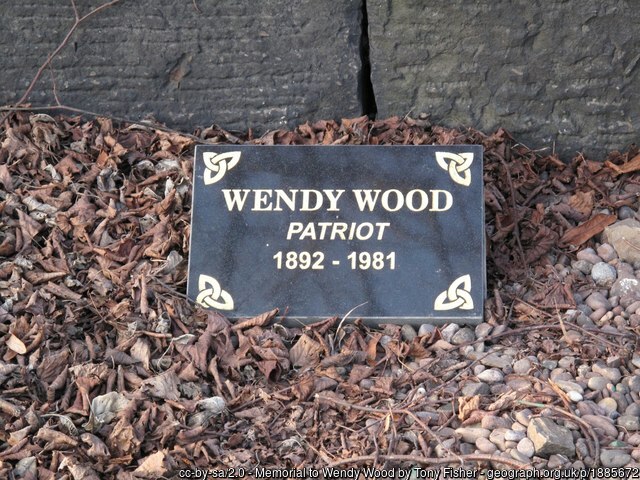Regular readers of this blog will be familiar with the Turbulent Londoners posts, where I celebrate the lives of Londoners who have played a part in the city’s rebellious history. As I recently moved to Edinburgh, I thought it would be fun to take a look at some of the women who made an impact on Scotland’s radical history. First up is Wendy Wood, artist, campaigner, and committed nationalist.

Scottish nationalism gained traction throughout the twentieth century. Wendy Wood was an important figure in the Scottish independence movement for much of this time. Preferring direct action to political maneuvering, she was a controversial figure, even within the nationalist movement. Nevertheless, there is no doubt that she was a fearsome, dedicated campaigner.
Gwendoline Emily Meachum was born to Scottish parents in Kent on 29th October 1892. Her mother told her stories of William Wallace, but she did not grow up in Britain, let alone Scotland. The family moved to South Africa for her father’s work, and Wendy’s experience of the Boer War as a young child probably shaped her later politics; it was not uncommon for Scottish nationalists to compare themselves to the Boers.
Wendy went to school in England, discovering a passion for art. She studied in London, including at the Westminster School of Art. She was involved in politics from a young age, and was a supporter of the suffragettes. Aged just 19, Wendy married Walter Robertson Cuthbert in 1913 and moved to Ayr. The couple toured Scotland, and in her later years Wood talked about having an epiphany about the significance of nationalism at the Wallace Monument during this road trip.
Wendy had two daughters (Cora and Irralee) during the first World War. She also became increasingly active in nationalist politics, joining the Scottish League in 1916 and the Scottish Home Rule Association in 1918. In 1923 she got a job with BBC radio, and would go on to become a successful storyteller and illustrator of children’s books. In 1927 she divorced her husband and started to use her mother’s maiden name, Wood.
When the National Party of Scotland was founded in the 1928, Wood was an early supporter. The National Party would merge with the Scottish Party to become the Scottish National Party in 1934. Wood worked hard to promote the cause of nationalism; she became an effective public speaker, and toured Scotland speaking at public meetings. In 1957 alone she gave 73 speeches.
Wood was a firm believer that cultural nationalism was just as important as political and economic nationalism. She founded Scottish Watch in 1931, a youth organisation the encouraged its members to learn about Scottish culture. For example, she organised mass Scottish country dances in Princes Street and Castle Esplanade in Edinburgh. At its height, Scottish Watch was more popular in Scotland than the Scouts.
Wood always preferred direct action to negotiation and compromise. In 1932 she led a group of nationalists into Stirling Castle to take down the union flag and replace it with a lion rampant. This was particularly embarrassing for the British soldiers stationed in the castle, and Wood was criticised by some members of the National Party of Scotland for taking such a symbolic step.
In 1947 Wood embarked on a fundraising and publicity trip around America, speaking to large crowds of expatriate Scots. She was also given an official position in the Scottish National Party. She didn’t like the restrictions of party politics, however, and left to form the Scottish Patriots in 1949, an organisation dedicated to cultural nationalism.
Wood was involved in several successful campaigns in the 1950s and 60s, including persuading the Church of Scotland to adopt a policy of home rule in 1961, pressuring the Post Office to issue Robert Burns stamps in 1966, and getting the Elizabeth II motif removed from post boxes (Scotland was never ruled by Elizabeth I). In 1972, she started a hunger strike when the British government failed to deliver on a promised referendum, and only stopped when she received a promise that the issue would be discussed in Parliament.
Scottish nationalism was not the only cause Wood supported. She started an anti-conscription league in 1933, and was imprisoned for the first time for trying to disrupt a fascist rally in Edinburgh. She also went to prison in Glasgow to draw attention to the awful conditions faced by female prisoners. In the 1930s and 40s Wood supported Indian Independence and she sided with Iceland during the Cod Wars in the 1970s.
Wood continued to campaign into her 80s. She was uncompromising in her beliefs; for example, she had a union flag placed under the carpet on the stairs of her Edinburgh home so that she could tread on it every day. She was passionate about Scottish culture and folklore, and helped define Scottish nationalism over more than 50 years of fighting for Scottish independence. She died on 30th of June 1980.
Sources and Further Reading
Crow House Kitchen. “Scots Women of History. 2 – Wendy Wood.” Last modified 27th June 2014, accessed 23rd September 2020. Available at https://crowhousekitchen.wordpress.com/2014/06/27/scots-women-of-history-2-wendy-wood/
MacPherson, Hamish. “Wendy Wood: A Scottish Patriot to her Very Core.” The National. Last modified 21st April 2020, accessed 23rd September 2020. Available at https://www.thenational.scot/news/18392801.wendy-wood-scottish-patriot-core/
Pittock, Murray G. H. “Meacham [married name Cuthbert], Gwendoline Emily [pseud. Wendy Wood].” Oxford Dictionary of National Biography. Last modified 24th May 2008, accessed 18th September 2020. Available at https://doi.org/10.1093/ref:odnb/40380 [Subscription required to access].

She was a very remarkable person. I used to attend her parlours at her Edinburgh home. A lot of people went to this Sunday afternoon gatherings, and learned a lot about our nation’s history. She didn’t just have a Union Jack under her stair carpet. After a lifetime of removing these, they formed the underlay of her entire house. She was great!
LikeLike
Thank you for sharing your memories. She sounds like a fantastic woman!
LikeLike